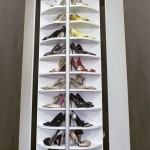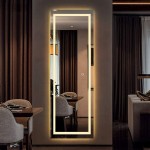How To Keep Bathroom Mirrors Fog-Free
The persistent fogging of bathroom mirrors after a hot shower is a common household nuisance. This phenomenon occurs due to condensation. Warm, moist air from the shower comes into contact with the cooler surface of the mirror. The water vapor in the air then cools rapidly and condenses back into liquid water, forming a thin layer of fog that obscures the reflection. While temporary, this fog can be frustrating, requiring wiping or waiting for it to dissipate before the mirror is usable. This article will explain several methods to prevent or minimize this fog, enhancing the functionality and convenience of the bathroom environment.
Proper Bathroom Ventilation
Adequate ventilation is critical in managing moisture levels within the bathroom. The installation and correct operation of a bathroom exhaust fan are the first line of defense against mirror fog. An exhaust fan effectively removes moist air from the bathroom, reducing the humidity that contributes to condensation. The size and power of the fan should be appropriate for the size of the bathroom. Overpowering is preferable than underpowering in this case, as the primary goal is to remove moisture. The effectiveness of the fan also depends on proper installation and ducting to the outside of the house. Ensure that the fan vents directly to the exterior and not into an attic or other enclosed space. Improper venting can lead to moisture accumulation in other areas of the house, potentially causing mold growth and other structural problems.
Regularly cleaning the exhaust fan is also vital. Dust and debris can accumulate on the fan blades and within the housing, reducing its efficiency. Check the fan is free from any obstruction. The amount of time to run the exhaust fan is also important. It is recommended to operate the fan during the shower and for at least 15-20 minutes afterward to ensure that the majority of the moisture has been removed from the air. Extending this time in smaller, less ventilated bathrooms is often beneficial. If the bathroom lacks an exhaust fan, consider having one installed by a qualified electrician. While this involves an initial investment, the long-term benefits of reduced moisture and improved air quality generally outweigh the cost.
Another aspect of ventilation involves the natural airflow within the bathroom. Opening a window during or after a shower can also help to vent moist air, especially when combined with an exhaust fan. However, this method is less effective in humid climates or during colder months when opening a window is not practical. In such cases, relying primarily on the exhaust fan is the better approach. Consider the use of dehumidifiers in the bathroom, although less common, can be effective in particularly humid environments or bathrooms prone to excessive condensation. Portable dehumidifiers are readily available, although they take up floor space and require emptying of the collected water. Permanently installed dehumidifiers offer a less obtrusive solution, but require professional installation.
Applying Fog-Resistant Coatings and Solutions
Various commercially available products and homemade solutions can create a temporary fog-resistant coating on the mirror surface. These products work by reducing the surface tension of water, causing it to spread into a thin, transparent layer rather than forming droplets that cause fogging. The effectiveness of these solutions varies, and regular reapplication is generally necessary.
Commercial anti-fog sprays, often used for car windshields or eyeglasses, are readily available at automotive supply stores and online retailers. These sprays typically contain surfactants that create a hydrophilic surface, preventing water droplets from forming. When using these sprays, it is crucial to follow the manufacturer's instructions carefully. Typically, the spray is applied to a clean, dry mirror surface and then wiped off with a clean cloth. It is essential to avoid using abrasive cleaners or cloths, as these can damage the mirror surface. The duration of the anti-fog effect varies depending on the product and the humidity levels in the bathroom, but reapplication is usually necessary every few days or weeks.
Several homemade solutions can also provide a fog-resistant effect. One common method involves mixing equal parts of white vinegar and water in a spray bottle. The solution is then sprayed onto the mirror surface and wiped off with a clean cloth. Vinegar is a natural cleaner and contains acetic acid, which helps to reduce surface tension of the water. Another solution involves applying a thin layer of shaving cream to the mirror and then wiping it off completely with a clean, dry cloth. The shaving cream leaves behind a thin film that prevents water droplets from forming. Both of these homemade solutions are cost-effective and readily available, but they may not be as effective or long-lasting as commercial anti-fog sprays. Reapplication is typically required more frequently.
Another option is the use of rain repellent products, sometimes used on car windshields. These products are designed to create a hydrophobic surface, causing water to bead up and roll off, which can be effective against fogging, but these may not be safe for all types of bathroom mirrors. It is essential to test any product in an inconspicuous area before applying it to the entire mirror surface to ensure that it does not damage the mirror's reflective coating. When applying any type of anti-fog solution, it is important to ensure that the bathroom is well-ventilated to avoid inhaling any fumes. It is also advisable to wear gloves to protect the skin from irritation.
Installing Heated Mirrors or Demister Pads
For a more permanent solution, consider installing heated mirrors or demister pads. These devices work by gently warming the mirror surface, preventing condensation from forming. Heated mirrors are typically more expensive than demister pads but offer a more integrated and aesthetically pleasing solution. Both options require electrical wiring, so professional installation is generally recommended.
Heated mirrors are designed with a heating element embedded within the mirror itself. This element warms the entire mirror surface, preventing condensation from forming. Heated mirrors are available in a variety of styles and sizes, and can be integrated into new bathroom designs or retrofitted into existing bathrooms. The installation typically involves connecting the mirror to the bathroom's electrical system, often wiring it to the light switch so that the mirror heats up when the lights are turned on. This ensures that the mirror is always ready for use after a shower.
Demister pads are thin, self-adhesive heating pads that are attached to the back of the mirror. These pads are typically less expensive than heated mirrors and can be applied to existing mirrors without requiring a complete replacement. The installation involves carefully cleaning the back of the mirror, applying the demister pad, and connecting it to the electrical system. Like heated mirrors, demister pads are often wired to the light switch for convenient operation. The size of the demister pad should be appropriate for the size of the mirror. Typically, the pad is positioned in the center of the mirror to provide even heating across the surface.
When installing either heated mirrors or demister pads, it is crucial to follow the manufacturer's instructions carefully and to ensure that all electrical connections are made by a qualified electrician. Improper wiring can create a fire hazard or damage the mirror or electrical system. Both heated mirrors and demister pads offer a long-term solution to mirror fogging, providing a clear and usable reflection even after a hot shower. These options are particularly suitable for bathrooms that are frequently used or for individuals who value convenience and a clear reflection.
In summary, maintaining a fog-free bathroom mirror involves a combination of strategies that address the root cause of condensation. Proper ventilation, the application of fog-resistant coatings, and the installation of heated mirrors or demister pads are effective methods that can significantly improve the functionality and user experience of the bathroom. The choice of method will depend on individual needs, budget, and the existing infrastructure of the bathroom. By implementing one or more of these strategies, one can enjoy a clear and unobstructed reflection after every shower.

How To Keep Your Bathroom Mirror Fog Free The Creek Line House

Cleaning Fan Shares Quick And Easy To Keep Bathroom Mirrors Fog Free All You Need Is Dish Soap The Us Sun

How To Keep Your Bathroom Mirror Fog Free The Creek Line House

How To Keep Your Bathroom Mirror Fog Free The Creek Line House

Cleaning Fan Shares Quick And Easy To Keep Bathroom Mirrors Fog Free All You Need Is Dish Soap The Us Sun

How To Keep Your Bathroom Mirror Fog Free The Creek Line House

How To Keep Your Bathroom Mirror Fog Free The Creek Line House

Keep Your Mirror Clean And Fog Free With Something You Already Have In The Kitchen

Keep Your Bathroom Mirror Fog Free Glass Doctor

Keep Your Bathroom Mirror Fog Free With These Handy S Academy Glass








